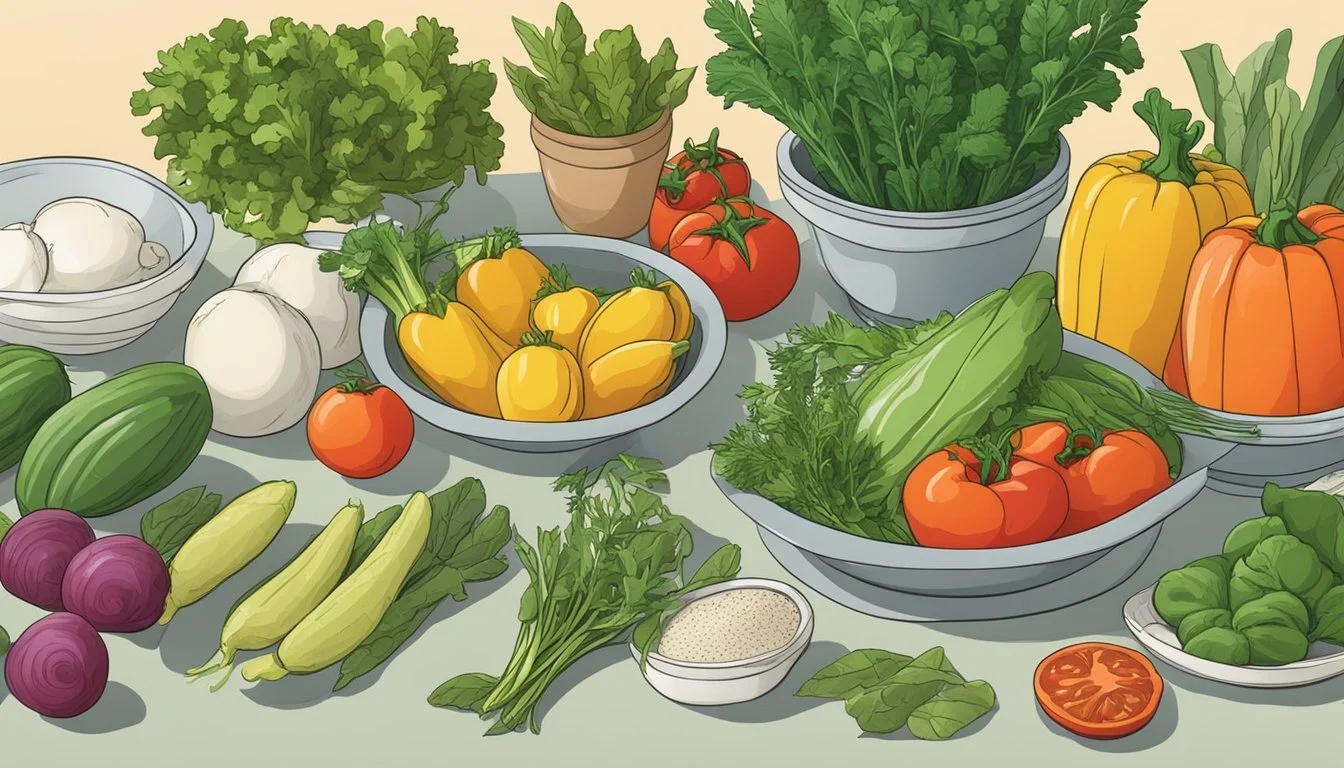Organizing Your Kitchen for a Mediterranean Diet
Essentials and Layout Tips
Embracing the Mediterranean diet centers around healthy eating habits that focus on heart-healthy, nutritious food choices. Characterized by its rich variety of plant-based foods, whole grains, lean proteins, and beneficial fats, it has been associated with numerous health benefits. Studies have linked the Mediterranean diet to a reduced risk of heart disease, among other health improvements. Organizing one's kitchen to facilitate this dietary pattern is an effective way to ensure that these principles are easily integrated into daily life.
The core of the Mediterranean diet includes a diverse selection of fruits, vegetables, legumes, nuts, seeds, and whole grains, complemented by moderate amounts of dairy, fish, and poultry. Oils, such as extra-virgin olive oil, serve as the principal source of fat, while red meat (What wine goes well with red meat?) is limited. By stocking the pantry and refrigerator with these staples, individuals can make meal preparation simpler and more conducive to these nutritional guidelines. Having readily accessible Mediterranean ingredients encourages the creation of varied and flavorful meals that align with the diet's emphasis on abundance and satisfaction, rather than restrictions.
Incorporating the healthful elements of the Mediterranean diet into everyday living requires thoughtful kitchen organization. Arranging foods to make them more accessible can lead to more frequent use and a seamless adoption of this eating style. One can create a kitchen environment that supports the Mediterranean diet's heart-healthy goals, ensuring that nutritious and wholesome food choices are at the forefront of meal planning and preparation.
Understanding the Mediterranean Diet
The Mediterranean Diet is not just a dietary plan but also a lifestyle choice, known for its nutrition-rich profile and numerous health benefits. Central to this diet are olive oil, fruits, vegetables, nuts, and whole grains, with a moderate intake of fish and poultry. Olive oil serves as the primary source of fat and is revered for its potential to reduce the risk of heart disease.
Key Components:
Plant-Based Foods: A spectrum of fruits, vegetables, nuts, and beans
Whole Grains: Unprocessed grains like bulgur and farro
Healthy Fats: Predominantly from olive oil, rich in monounsaturated fats
Frequent consumption of seafood enhances the diet's nutritional profile with essential omega-3 fatty acids. Red wine can be enjoyed in moderation, contributing to the lifestyle's sociocultural aspect.
Consumption Frequency Guidance:
Food Group Frequency Fruits & Vegetables Daily Whole Grains Daily Olive Oil Daily Fish & Seafood Twice a week Poultry & Eggs Moderate portions Red Wine Optional, moderate consumption
Dairy is consumed in low quantities, and red meats are limited, supporting a balanced approach to meal construction. The individuals who follow the Mediterranean Diet may notice improved heart health and an overall enhancement in well-being, given its emphasis on whole foods and heart-healthy fats. This approach to diet aligns closely with dietary recommendations for preventing chronic diseases and maintaining overall health.
Essential Mediterranean Ingredients
When organizing your kitchen for a Mediterranean diet, it's essential to stock up on a variety of natural, nutrient-dense foods, minimizing processed items. This diet emphasizes heart-healthy fats, whole grains, proteins, legumes, fruits, and vegetables.
Proteins in Focus
The Mediterranean diet includes a diverse range of proteins that are rich in nutrition and support a healthy lifestyle. Seafood, particularly fish like salmon and tuna (What wine goes well with tuna?), is consumed regularly due to its high omega-3 fatty acid content. Poultry such as chicken, as well as eggs, are also common, providing additional lean protein options. Red meat is limited in this diet, with a focus instead on plant-based proteins like beans, legumes, lentils, and chickpeas.
Vegetables and Fruits
A cornerstone of Mediterranean eating, vegetables and fruits serve as the diet's main source of vitamins, minerals, and fiber. Staples include spinach, tomatoes, potatoes, peppers, and olives, alongside a variety of greens. Additionally, avocados and berries offer healthy fats and antioxidants, respectively. Fruits such as figs and pomegranates are valued for their nutrient profile and savory-sweet balance.
Whole Grains and Legumes
Whole grains are central to the Mediterranean pantry. Rice varieties like Arborio provide a base for dishes like risotto, while quinoa, oats, barley, farro, and bulgur are key for nutrition and satiety. Pasta and couscous (What wine goes well with couscous?), including whole-grain options, are integrated in moderation. Legumes, including beans and lentils, are important for their protein and fiber.
Dairy and Nuts Choices
Dairy is present in the form of yogurt, especially Greek yogurt, and cheeses like feta, goat, and Parmesan which are consumed in moderation. Nuts such as almonds, walnuts, and pistachios are used both as snacks and ingredient in recipes, valued for their healthy fats and protein content.
Oils, Herbs, and Spices
Olive oil is the primary fat source, used in cooking and dressings for its heart-healthy properties. Herbs such as basil, oregano, rosemary, and parsley infuse meals with authentic Mediterranean flavors. Spices, like cinnamon and garlic, enhance dishes while offering health benefits. Vinegar - particularly red wine vinegar - and honey complement the diverse flavor palette.
Miscellaneous Staples
Additional staples include seeds such as chia and flaxseed, tea for its antioxidant properties, and red wine enjoyed in moderation. Water remains the drink of choice, essential for hydration. These items, while not the centerpiece of meals, contribute to the overall balance and nutrition profile of the Mediterranean diet.
Setting Up Your Mediterranean Pantry
A well-organized pantry is the backbone of healthy eating on the Mediterranean Diet. It ensures that staples such as olive oil, whole grains, and legumes are always on hand for nutritious meals.
Pantry Essentials
Grains: A variety of grains provide the necessary complex carbohydrates and fibers.
Whole Wheat Pasta: For classic Mediterranean dishes.
Maftoul & Couscous: Great bases for salads and sides.
Rice: Preferably short-grain or medium like Arborio for risottos.
Oils, Vinegars, and Condiments: Essential for flavoring and cooking.
Extra Virgin Olive Oil: A Mediterranean staple for cooking and dressings.
Balsamic Vinegar: For salads and reductions.
Red Wine Vinegar: Versatile for dressings and marinades.
Canned Tomatoes: Both whole and diced for sauces and stews.
Herbs and Spices: The essence of Mediterranean flavor.
Dried Oregano, Basil, and Thyme: Common in Greek and Italian cuisines.
Cumin and Paprika: For a touch of warmth and depth.
Garlic Powder and Onion Powder: Convenient for a quick flavor boost.
Refrigerator and Freezer Items
Dairy: Select dairy items for their calcium and protein.
Greek Yogurt: For breakfasts, smoothies, or as a substitute for sour cream.
Cheeses: Feta and Parmesan are favorites to sprinkle over dishes.
Fresh Produce: Incorporate a variety of colors and nutrients.
Vegetables: Eggplants, bell peppers, tomatoes, and leafy greens.
Fruits: Lemons for zest and juice, apples, and grapes.
Frozen Produce: Ideal for off-season months or convenience.
Berries: For antioxidants and sweetness in desserts or yogurt.
Spinach: For a quick addition to pastas and omelets.
Shelf-Stable Proteins
Legumes and Beans: For fiber and plant-based proteins.
Lentils: Easily cooked for soups and salads.
Chickpeas: Perfect for hummus or as a salad topping.
Kidney Beans & Fava Beans: Hearty additions to meals.
Canned Fish: A quick protein source rich in omega-3s.
Tuna: For salads and sandwiches.
Sardines: To be enjoyed on crackers or in pastas.
Nuts and Seeds:
Almonds, Walnuts, and Pine Nuts: Great for snacking or adding crunch to salads.
Chia Seeds and Flaxseeds: For a dose of omega-3 and fiber in smoothies or as toppings.
Planning Mediterranean Meals
Organizing your kitchen for the Mediterranean diet revolves around having a strategic meal plan that emphasizes fresh, whole foods and minimizes processed items. The following subsections offer a range of ideas and strategies to help one enjoy the full benefits of this nutritious diet.
Breakfast Ideas
Eggs: A staple of the Mediterranean diet, eggs can be prepared in various ways, including poached or boiled, and served with sautéed greens and whole-grain toast.
Yogurt and Fruit: Start the day with a bowl of Greek yogurt topped with a mix of fresh fruits, nuts, and a drizzle of honey for a quick and nutritious option.
Oatmeal and Whole Grains: Oatmeal or other cooked whole grains like quinoa, garnished with sliced fruits and a sprinkle of cinnamon, provide a fiber-rich breakfast.
Lunch Strategies
Salads: A hearty Mediterranean salad can include a mix of colorful greens, cherry tomatoes, cucumbers, olives, and feta cheese, dressed with olive oil and lemon juice.
Legumes: Incorporate various beans or lentils into lunchtime soups or salads for added protein and fiber.
Tuna: Create tuna salads with a Mediterranean twist by skipping the mayo and mixing in olive oil, lemon juice, diced vegetables, and herbs.
Dinner Themes
Fish and Seafood: Grilled, roasted, or baked fish and seafood, seasoned with herbs and served with a side of vegetables, make for a simple and heart-healthy dinner option.
Chicken and Grains: Marinated chicken with herbs served alongside whole grains like farro or brown rice offers lean protein and complex carbohydrates.
Legume-Based Dinners: Chickpea stews or lentil curries provide a warming and nutritious end to the day, paired with a side of whole-grain bread.
Snacks and Treats
Nuts and Cheese: A small portion of nuts paired with a piece of cheese can satisfy midday hunger pangs and provide a good balance of fats and proteins.
Fruits: Fresh or dried fruits serve as a sweet, fiber-rich snack choice.
Hummus: Homemade hummus served with vegetable sticks or whole-grain pita is both filling and aligns with healthy eating principles of the Mediterranean diet.
Healthy Eating Habits and Tips
When adopting the Mediterranean diet, healthy eating involves incorporating a variety of nutrient-dense, minimally processed foods and emphasizing plant-based options. An individual's meal plan should be centered around fruits, vegetables, whole grains, nuts, and seeds, with olive oil as the primary source of added fat.
Fiber: A rich intake of fiber through whole grains, beans, and legumes supports digestive health and can contribute to weight loss. Whole grains like barley and farro can be excellent bases for meals.
Water: Staying hydrated is critical. Individuals should drink plenty of water throughout the day and can enjoy other beverages like herbal tea in moderation.
Regular Meal Times: They should aim for consistency in meal times to help regulate their body’s hunger signals and metabolic processes. Eating smaller, more frequent meals may also aid in weight management.
Strategic Snacking: Opting for a handful of raw nuts or vegetables instead of processed snacks can provide essential nutrients and keep hunger at bay between meals.
Mediterranean Diet Components Suggested Servings Fruits and Vegetables At least 5 servings per day Whole Grains 4-6 servings per day Nuts and Seeds A handful per day Olive Oil About 3 tablespoons per day Water 6-8 glasses per day
In the Mediterranean diet, meals are not just about the food on the plate; they also involve the social aspect of dining. Sharing meals with others, taking time to savor food, and being mindful of one's eating habits are integral parts of this dietary pattern.
Shopping and Preparing Foods
Embarking on a Mediterranean diet involves strategic shopping and meal preparation. Here, you'll learn how to decipher the shopping list for essential ingredients, proper storage and meal prep techniques, cooking methods suited to Mediterranean dishes, and guidelines for portion sizes.
Deciphering the Shopping List
Shopping List: When shopping for a Mediterranean diet, the list should predominantly feature plant-based items like fruits and vegetables, complemented by whole grains, legumes, nuts, and seeds. Healthy fats are sourced from products such as extra virgin olive oil. Integrate a variety of seafood twice a week, and add minimal portions of poultry, eggs, and dairy. The shopping list should consist of:
Fresh Produce: Tomatoes, cucumbers, spinach, kale
Whole Grains: Brown rice, whole wheat pasta
Protein: Lentils, chickpeas, white fish (What wine goes well with white fish?), chicken
Healthy Fats: Olives, avocados, extra virgin olive oil
Herbs and Spices: Basil, oregano, rosemary
Storage and Meal Prep
Storage: Proper storage extends the freshness of produce and maintains nutrition. Vegetables and fruits are best kept in different compartments of the refrigerator to prevent ethylene production from affecting their longevity. Whole grains and spices should be stored in airtight containers in a cool, dark place.
Meal Prep: To efficiently adhere to a meal plan, it’s beneficial to wash and chop vegetables ahead of time for easy access. Grains can be pre-cooked and stored in the fridge for up to a week. Prepping ingredients in batches ensures seamless meal assembly during the week.
Cooking Mediterranean Dishes
Cooking in the Mediterranean style focuses on grilling, baking, or sautéing rather than frying. Usage of aromatic herbs and spices takes precedence over salt, enhancing both the flavor and nutritional content of the dishes. Incorporating an abundant selection of vegetables into recipes can transform even simple meals like salads into fiber-rich, nutritious options.
Sauté spinach with garlic in olive oil for a quick side.
Bake fish with a topping of chopped tomatoes, olives, and capers. (What wine goes well with capers?)
Portion Sizes and Servings
Portion Control: A fundamental part of nutrition in the Mediterranean diet is managing portion sizes. Proteins should not be the centerpiece of the meal; instead, they accompany the plant-based components. For example, a typical serving size of fish would be about the size of a checkbook, while salads and vegetables may take up half the plate.
Servings: Eating a variety of foods in moderation ensures a balanced intake of fiber, proteins, and healthy fats. It is recommended to consume:
At least four to six servings of vegetables per day
Four servings of fruit
Four to six servings of whole grains
Two to three servings of dairy, mostly in the form of cheese or yogurt
Following these guidelines will assist in maintaining a well-rounded Mediterranean diet.
Integrating the Mediterranean Diet into Your Lifestyle
The Mediterranean Diet offers a plethora of benefits like bolstering heart health and supporting weight loss, making its integration a lifestyle goal for health-conscious individuals. The incorporation of this diet's principles revolves around adjusting daily eating habits and ensuring a diverse intake of nutrition-rich foods.
Eating Out and Social Events
When dining out or attending social gatherings, individuals can follow the Mediterranean Diet by opting for dishes loaded with vegetables, whole grains, and lean proteins such as fish or chicken. Salads, grilled seafood, and vegetable-based dishes are good choices. It is important to watch for hidden fats and sugars commonly found in restaurant meals. If available, reinforcing the Mediterranean principle can mean choosing whole-grain bread options, enjoying a glass of red wine in moderation, and sharing a healthy dessert like fresh fruit.
Adjusting Family Meals
Altering family meals to suit the Mediterranean lifestyle usually entails small, incremental changes rather than drastic overhauls. Begin by introducing more plant-based foods, such as swapping out red meat for servings of legumes or fish a couple of times a week. Use olive oil as the primary fat for cooking and salads. Whole-grain pasta, breads, and rice serve as hearty, satisfying bases for meals, while moderate portions of dairy, like feta or yogurt, can enhance flavors.
Sample Adjustments:
Protein: Choose fish and poultry over red meat.
Fats: Replace butter with olive oil.
Grains: Select whole-grain options whenever possible.
Sweets: Introduce fruit as a regular dessert.
Maintaining Balance and Variety
The key to sustaining the Mediterranean Diet as part of one's lifestyle lies in maintaining nutritional balance and variety. Rather than focusing on restrictions, the diet encourages a wide range of food groups, emphasizing quality and nutrient density. For heart-healthy living, include a colorful array of fruits and vegetables, integrate healthy fats like nuts and seeds, consume seafood twice a week, and opt for whole-grain carbohydrates.
Balanced Meal Plan Components:
Fruits and Vegetables: At least half of the plate
Whole Grains: A quarter of the plate
Lean Proteins: The remaining quarter of the plate (with a focus on fish)
Healthy Fats: Include at every meal, such as olive oil or avocados
Practicing these dietary modifications can help ease individuals into a Mediterranean way of eating, which is not only beneficial for weight management but also for fostering overall healthy living.
Conclusion
Adopting a Mediterranean Diet aligns with a lifestyle of healthy eating, where nutrition is paramount, and fresh ingredients take center stage. A well-organized kitchen is a foundation for creating meal plans that embrace the principles of the diet, ensuring that they have access to the necessary staples.
Meal Preparations: They should consider prepping meals in advance, such as roasting a variety of vegetables and incorporating whole grains. Strategically planning the week's meals can minimize stress and encourage adherence to dietary goals.
Health Benefits: Research indicates a Mediterranean Diet can support heart health and contribute to a reduction in chronic disease risk. Therefore, maintaining an environment conducive to this diet is pertinent for reaping its potential health benefits.
Lifestyle Integration: By doubling down on the principles of the Mediterranean Diet—ample vegetables, legumes, nuts, and olive oil—individuals can fully embed these habits into their lifestyles. It's not just about the food; it's about creating a sustainable, enjoyable approach to eating.
Nutrition Focus: Supporting a balanced diet rich in fruits, vegetables, whole grains, and healthy fats is an integral aspect of the Mediterranean ethos. Ensuring that the kitchen is stocked with these nutritional powerhouses simplifies the process of making beneficial dietary choices.
By underscoring the importance of organizational strategies in the kitchen, one can facilitate a smooth transition to the Mediterranean Diet, reflecting a purposeful step towards long-term well-being and health-conscious living.









